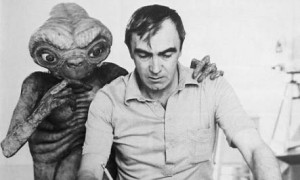
De Laurentiis brought Rambaldi to America when the former was planning a big budget remake of King Kong in the mid-1970s when other Italian artisans were not available. Though versions of the development of the effects for the film wildly differ, Kong himself was originally going to be created as a 40-foot animatronic creature for the film’s entirety. Numerous production problems ensued with the full creature’s performance, relegating the full head-to-toe beast to only five shots in the finished film. In place of the giant underperforming robot, Rambaldi implemented his mechanical expertise in concert with special makeup effects and creature creator Rick Baker’s sculptures and design work, creating a suited Kong which Baker wore throughout more than 95 percent of Kong’s scenes. Baker’s expressive facial sculptures and overall suit designs were actuated with Rambaldi’s team and mastery of mechanical coordination for a suit and head so intricate that it required a large team to operate Baker’s various facial effects while he performed the different body movements. Additional full-size body pieces were created, including Kong’s giant mechanical arms, to interact with actors and life-size sets.
The eventual 1976 Kong has been criticized for its modernization of the tale and lack of dinosaurs, but the Kong character himself was a breakthrough in the advent of a special character’s expressiveness, all practically achieved on sets in a time long before computer-generated animation was commonplace. Rambaldi’s presence was thereby felt in Hollywood, and Steven Spielberg enlisted him to create a similarly believable on-screen alien for the climactic sequence in 1977’s Close Encounters of the Third Kind. Though seen only briefly at the end of the film, Rambaldi’s final creature moved fluidly in the shot, blinking its eyes and even smiling, offering the most realistic on-screen extraterrestrial to that point. Spielberg would recruit Rambaldi again to create an unprecedented alien for his upcoming fantasy, a sequel of sorts to Close Encounters.
But before another benevolent extraterrestrial would grace the screen, Ridley Scott brought Rambaldi into his space epic Alien, which was released in 1979. While H.R. Giger designed the aliens and other film elements, Rambaldi would build the main creature’s mechanical head with unforgettable inner protruding teeth. Spielberg’s next alien reared no such menacing features, and Rambaldi’s mechanical devices developed in Italy and advanced to new levels on King Kong and Close Encounters would be perfected with E.T. – The Extra Terrestrial. Unlike any which had come before it, the final E.T. creature was a living, breathing character with a host of pioneering mechanical abilities, provided by a carefully assembled team. Different artists were assigned to manifest E.T.’s eyes, “heart light,” paint job, and other effects, all working under Rambaldi’s supervision.
When De Laurentiis next acquired the rights to Frank Herbert’s Dune, he naturally turned to Rambaldi to create the many alien creations noted in the story. Of those, the top achievement was the massive “navigator” character, a slug-like beast that, again, moved believably and provided some of the film’s more enduring moments.
By the mid-1980s, Rambaldi was in his 60s and slowed his pace significantly. He kept homes in Los Angeles and Italy during his last 20 years and consulted on several projects, but never reached the heights of the 10 aforementioned years. His legacy remains a creator of mechanical film characters whose practical animation abilities could only thereafter be achieved by the use of extensive computer graphics and, arguably, have not been surpassed even with modern methods.





